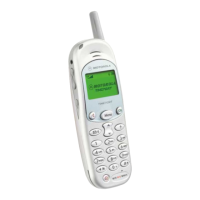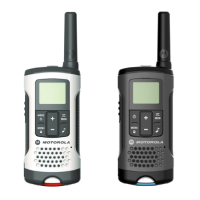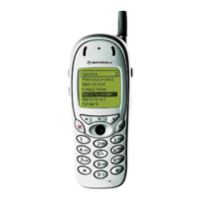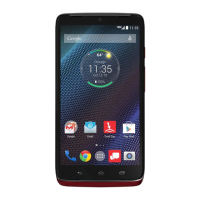PM Theory:A17
This document is propriety of MOTOROLA and it
should be return if not used .
Distribution and copies of this document are not
allowed with out MOTOROLA approval.
BOARD - P6.0
1 PM1000 Device Description
The PM1000 chip is a complete power-management system device for CDMA handset applications
whose primary functions provide battery management and charger control and linear voltage regulation
with programmable voltages for digital and RF/analog circuits. This device only supports the use of a
regulated external charger pack (Subsystem 1). The regulated charger pack provides both a constant
current and constant-voltage source. Over voltage and over current protection are not utilized, since the
regulated charger pack provides these protections. The battery management includes low batter
alarm, and accurate battery gas gauge. The charger control includes charge modes for Lithium-Ion (Li
Ion) and Nickel Metal Hydride (NiMH) batteries. The voltage regulation includes power-on reset control.
There are two charging modes within the charging subsystem, a trickle charging system and a fas
charging system. The PM1000 device supports the use of only a single battery system, which includes
a low battery voltage alarm. A coulomb counter, which indicates battery energy and drives a gas gauge
function, is included on the PM1000 device. It senses both the charging and the discharging of the
battery and is also used to detect the End of Charging Detection (EOCD). The PM1000 also contains
eight Low Dropout (LDO) Voltage Regulators to provide regulation to both the RF and digital sections o
a CDMA phone. Using QUALCOMMs three wire Serial Bus Interface (SBI), the microprocessor is able
to control and program each regulator independently. This gives the microprocessor the ability to turn
off and on various systems and adjust the output voltages of the LDOs as system loads vary and
battery voltages change. In addition, a Startup State Machine is used to control the power-up
sequencing of the PM1000 device. A sub-system related to Power On sequencing is the Slotted Cycle
Index (SCI), which is used to manage the TCXO clock through the control of the TCXO LDO and the
PM1000 TCXO buffer.
In addition to the power management function, the PM1000 device also contains a variety o
collateral support functionality including a general purpose Analog-to-Digital Converter (ADC), a Real
Time Clock, keyboard backlight driver, Liquid Crystal Display (LCD) backlight driver support,
ringer/buzzer driver, and a vibrator driver.
The PM1000 device contains an eight input analog multiplexer (5 external, 3 internal) that is
connected to a full-scale general purpose 10-bit ADC. The three internal inputs to the multiplexe
include dual battery voltage monitoring and charger voltage monitoring. The five external inputs can be
used to monitor various system parameters such as temperature, battery ID and RF output power.
The PM1000 devices Real Time Clock (RTC) generator is based upon an external sleep crystal
oscillator operating at 32 kHz (32.768 kHz). An internal RC oscillator circuit is used to provide the 32
kHz sleep clock until the 32-kHz crystal is stabilized. Once the crystal stabilizes, an SBI command will
switch over from the RC oscillator to the external crystal. The RTC remains active when the entire
phone is put into a sleep mode. A key function of the RTC is for FM mode in dual mode handsets where
no clock is available through the network. An optional button cell battery can be used to keep the RTC
running when the phone has been turned off or the battery pack has been removed. This allows the
phone to maintain the time and calendar function when network timing is unavailable. The cloc
generator contains a clock counter, calendar counter, automatic leap-year recognition (to 2020).
The backlight drivers are used to control the brightness of the keyboard and LCD. Both the
keyboard driver and the LCD backlight driver produce a programmable constant current sink to control
the brightness of the LCD. An optional Electro-Luminescent (EL) Display driver support is also included
on the PM1000 device. The Electro-Luminescent driver support provides the required interfacing and
four programmable levels of intensity to Sipexs SP4416 EL driver. The PM1000 device also has a
vibrator driver and a buzzer/ringer driver. The vibrator driver constant voltage source is used to drive a
small DC motor to silently alert the user of an incoming call. The ringer driver is used for a phones
buzzer or ringer device. Because the vibrator and ringer drivers are independent of one another, the
can both be simultaneously driven for applications requiring dual functions.
All PM1000 device operating modes and functionality can be controlled by the MSM3000 o
MSM5105 microprocessor through their three-wire Serial Bus Interface (SBI). This chip will be available
in a 64 fine pitch plastic ball grid array (FBGA) package.
98

